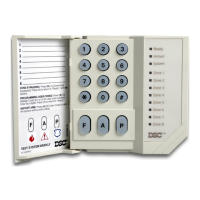
Do you have a question about the DSC PC1500 and is the answer not in the manual?
| Backlight | Yes |
|---|---|
| Voltage | 12 VDC |
| Compatibility | DSC PowerSeries |
| Current | 50mA |
| Operating Temperature | 0°C to 49°C (32°F to 120°F) |
| Weight | 0.5 lbs (0.23 kg) |
Equipment monitors fire detectors and provides a warning if a fire condition is detected.
Ensures the system continues to function as intended through weekly testing.
Explains the system components, control panel, keypads, and zone protection.
System cannot prevent emergencies; it alerts to situations and requires professional installation.
Checks system status like bypass, trouble, and ready lights before arming.
Procedure for entering access code to arm the system.
Arms system and automatically bypasses interior zones for home-away scenarios.
Procedure to arm the system and eliminate the entry delay.
Procedure to enter premises and disarm the system using the access code.
Allows arming the system by pressing [*][0] instead of an access code.
Provides a tone from the keypad when a door or window is opened or closed.
Procedure to test system components like keypad, buzzer, battery, and bell/siren.
Guidance on changing the Master Code and programming additional access codes.
Details on using a single-use code for entry and exit.
Shows which zone caused the last alarm after disarming.
Procedures for responding to fire and intrusion alarms, including silencing and investigation.
Allows disabling specific zones from triggering an alarm.
Recalls the previously bypassed group of zones.
Monitors system trouble conditions and how to view them.
Explains the function of [F] Fire, [A] Auxiliary, and [P] Panic keys.
Holding the [P] key for two seconds activates a panic alarm.
Details on alarm, silence, and reset procedures for fire alarms.
Weekly system testing procedure to ensure proper operation.
Fields for recording system zones, codes, entry/exit times, and service contact.
Information regarding FCC compliance and potential interference.
Customer notification requirements for connecting to the telephone company and network.
Explains REN and its use in determining connected devices.
Details the warranty period, coverage, and procedure for obtaining service.
Lists conditions that void warranty and disclaimers of other warranties.
Procedures and fees for repairing products outside the warranty period.
Installers must inform users of vital system information.
Circumstances where the system may not provide protection due to various factors.
